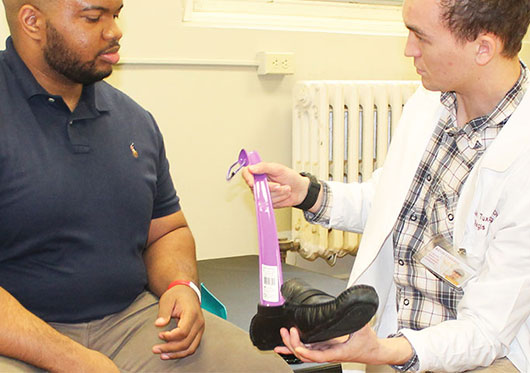An occupational therapist advocates for his profession as one of the few successful treatments without side effects.
The opioid crisis might be the most perfect illustration of the cure being worse than the disease. Yet to those for whom opioids are a last resort, few other medications are risk-free and no relief is simply not an option. That leaves non-medical treatments such as acupuncture, biofeedback, and, increasingly, occupational therapy. In 2018, The Substance Use-Disorder Prevention that Promotes Opioid Recovery and Treatment (SUPPORT) for Patients and Communities Act included occupational therapy (OT) as a non-pharmacological pain management treatment. According to American Occupational Therapy Association (AOTA), “The law opens new opportunities for occupational therapy in pain management and provides better access to non-pharmacological, interdisciplinary treatments for pain.”
 Enter Kyle Oatis. The Lilburn, Georgia, native took a roundabout route to the occupational therapy profession. “I became interested in [OT] as a whole while playing football observing our team therapist which lead me to want to learn more about rehabilitation,” he recalls. “I had the opportunity to shadow a hand therapist who introduced me to OT and I fell in love. Shortly after this I met my mentor who is a school based therapist and I quickly realized how wide my scope could be as an OT. I decided that it was without a doubt the profession for me. I moved to Boston [and] began looking at all of the OT programs in the area, however after sitting and talking with Dr. [Michael] Roberts for 10 minutes I was immediately sold. He had a vision for the program that placed an emphasis on turning out practitioners who were self-aware, compassionate, and educated.”
Enter Kyle Oatis. The Lilburn, Georgia, native took a roundabout route to the occupational therapy profession. “I became interested in [OT] as a whole while playing football observing our team therapist which lead me to want to learn more about rehabilitation,” he recalls. “I had the opportunity to shadow a hand therapist who introduced me to OT and I fell in love. Shortly after this I met my mentor who is a school based therapist and I quickly realized how wide my scope could be as an OT. I decided that it was without a doubt the profession for me. I moved to Boston [and] began looking at all of the OT programs in the area, however after sitting and talking with Dr. [Michael] Roberts for 10 minutes I was immediately sold. He had a vision for the program that placed an emphasis on turning out practitioners who were self-aware, compassionate, and educated.”
Michael Roberts is Director of the occupational therapy master’s program at Regis College. Host of the widely respected “I love OT Podcast,” Roberts is seen as something of a dean of the profession.
“I will never forget Dr. Roberts’ emphasis throughout the program to always look at our clients holistically,” Oatis adds. “Everyone is a sum of our perception, our environment, our character, our roles, our abilities, and our dreams, and all of these things directly play into our function. This helps me daily to remember to always make my work client centered and meaningful for whomever I come in contact with.”
Roberts sees Oatis “the kind of leader who measures success through building community and teamwork--a strong advocate for his clients and his profession.”
Today, Oatis works at Nmotion Hand and Physical Therapy, an outpatient clinic in Marietta, Georgia. “Here I work primarily with hands and upper extremity injuries such as broken wrist, elbows, and fingers,” he explains. “In my setting I develop interventions to help people return to function after something has occurred which is preventing them from their work, home, or leisure requirements.”
As an occupational therapist, what’s my role in the opioid epidemic?Kyle Oatis ‘20, occupational therapy
Kyle Oatis and Dr. Roberts Explain the Work OT is Doing to Help in the Opioid Crisis
Video curtesy of NECN.
"Though we may not be considered to be on the front lines as healthcare practitioners in the opioid epidemic, occupational therapists play an immensely large role in helping serve the community when it comes to combating opioid addiction. Admittedly, I did not realize my impact until my first year of practice when I had the opportunity to be a participant in AOTA (American occupational therapy association) Hill Day. During Hill Day, groups of both practitioners and students had the opportunity to speak with other local law and policymakers to advocate for our profession and unique skill set that we bring to healthcare. During this particular year, one large talking point involved speaking to lawmakers about the importance of including occupational therapy in the new legislation regarding essential services for non-pharmacological care. Prior to speaking with my local senator, this prompted me to reflect on my impact on my patients regarding this issue, and I realized how invaluable I was. As an OT treating hand and upper extremity, a large bulk of my patients present to the clinic with high pain levels. Some conditions such post-surgical pain, chronic conditions like arthritis and tendonitis, and traumatic accidents leading to sprains and fractures leave patients with not only increased pain level but also decreased abilities with performing the daily activities they consider to be essential."
Fear of Relapse
"During my couple of years of practice, I began to notice an increasing trend of patients who did not wish to take stronger prescription drugs for their hand and wrist, even if they were prescribed them. There were some patients who refrained from taking stronger medications due to what they have learned about the medications' side effects from research or even seeing ads on TV. I also began to notice a trend of patients who disclosed struggles with prior substance addiction, which caused them to be fearful of taking medication in fear of relapse. While working with these patients, I was able to utilize modalities, manual techniques, education on compensatory strategies, adaptive techniques, and graded activities all to assist them with pain reduction and return to the activities that were most meaningful to them. Having patients tell me things such as, “I was able to shave with the hand that was hurt,” or “I was able to make it through a yoga class without pain,” brings immense purpose to work and also reminds me as an OT that I have an important unique role in the rehab process."
Out of his Comfort Zone
"One particular patient that will always come to mind when I think of this subject was a young man who unfortunately fractured both of his elbows when he tripped over an uneven sidewalk at work. Outside of his day job, this patient was also a guitarist in a popular band, so his goals were to relieve pain and get strong enough to play again before his upcoming summer tour. While treating him, the patient disclosed to me that he had recovered from substance abuse in the past and preferred not to take the medications he had been prescribed for pain. Due to this he really looked forward to our treatment sessions and the feeling of making progress. With him, I would do things such as joint mobilizations, soft tissue massage, and gradual stretching to help him gain mobility. To help him gain strength and confidence I used a concept we learned in the OT program called grading tasks. Grading tasks entails increasing or decreasing the difficulty of an activity to meet that patient's capabilities. With him, we started with light lifting and carrying activities (one to two lbs.) such as carrying boxes and pushing carts and added a few lbs. every week. I was also able to utilize modalities such as TENs (transcutaneous electrical nerve stimulation) which utilizes low voltage electrical current to provide pain relief. During our treatment process, I always made sure to check in with him and his pain to respect and adjust anything out of his comfort zone. In the end, he made a full recovery, and went on to successfully go on his international tour and rocked out."
Considering stories like this, and the passage of The Substance Use-Disorder Prevention that Promotes Opioid Recovery and Treatment (SUPPORT) for Patients and Communities Act last fall, which includes occupational therapy as a service for non-pharmacological pain relief, it is safe to say that occupational therapists will continue to find avenues to provide safe and holistic treatment to help our clients live pain-free.





